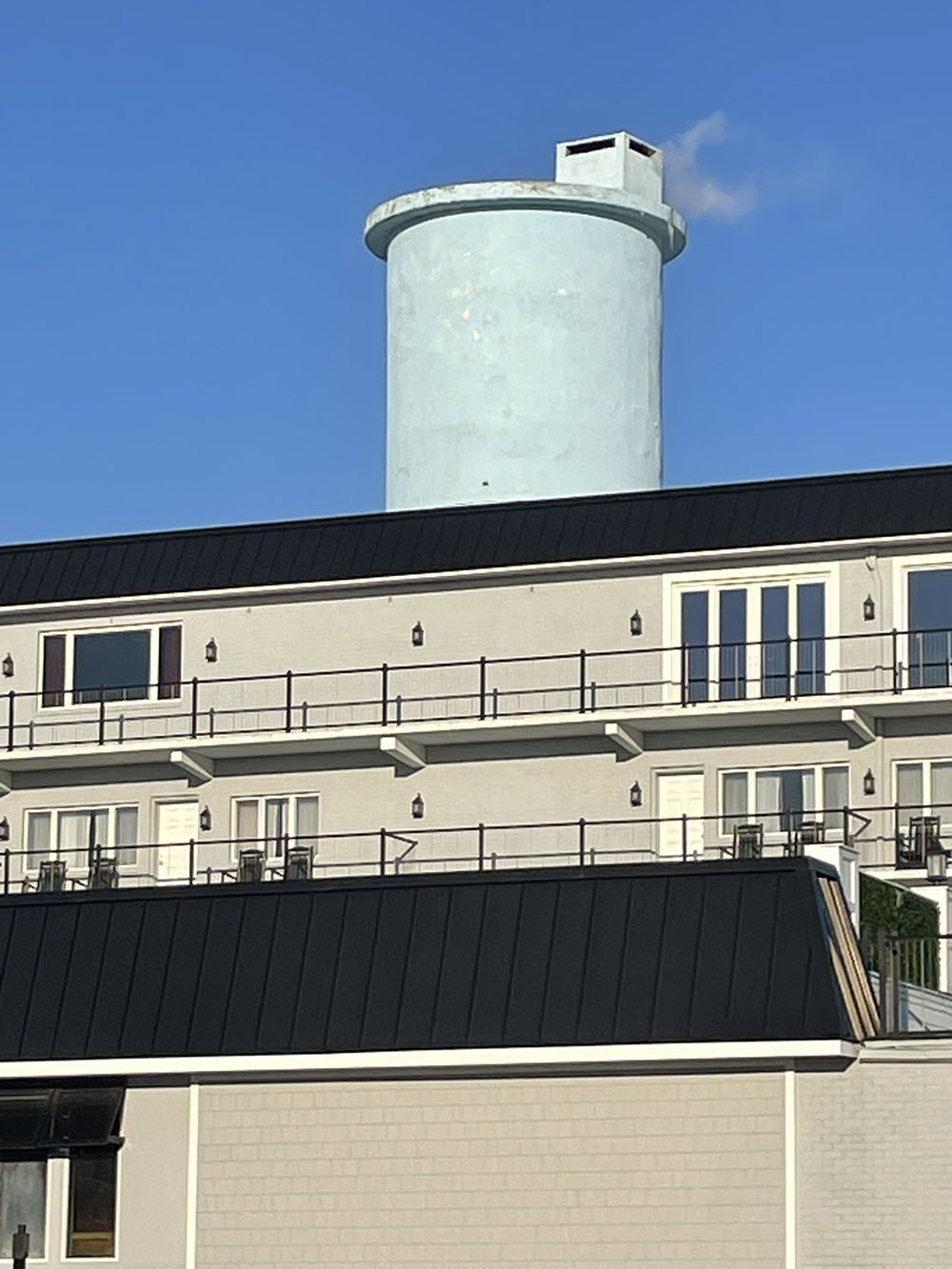Aboard the American Star
An intern’s experience with the Cape May Whale Watch and Research Center

After living in Cape May my whole life, I have seen many beautiful nature scenes in our small town. From the beaches of the Delaware Bay and the Atlantic Ocean to the wide marshlands that web around the waterways, there is no shortage of wonderful things to see. You can observe any number of bird species across the plethora of nature trails. I have seen eagles, ospreys, swans, and of course seagulls. From the beaches I have seen dolphins, crabs, horseshoe crabs, and other aquatic species that had been pulled from the water by fishermen on the shorelines. None of this compares however to what I have been able to experience in just one summer aboard the American Star.
I haven’t seen just dolphins and whales; I had the opportunity to experience them out in their natural habitat. As a biology major with an interest in environmental science, I was eager to find an internship within the field. Fortunately, with a little bit of luck and the help of a friend, I found myself in contact with the lead researcher of The Cape May Whale Watch and Research Center.
The Cape May Whale Watch and Research Center (CMWWRC) is just one of the two commercial whale watching companies that operate in Cape May. They are the owners of the blue vessel named the American Star. You more than likely have already heard of them or even seen them just off the beach of Cape May, as they run trips every day. The CMWWRC sets itself apart from other whale watching services by dedicating each trip to research, education, and conservation. They operate a 501c3 nonprofit, the Cape May Marine Mammal Research Center.




Lead researcher, captain, and naturalist Melissa Laurino devotes her time to observing and recording data on the Atlantic Bottlenose Dolphins that inhabit the coastal waters of Cape May in the spring, summer, and fall. She does this alongside her husband, Captain Matt Remuzzi. A major point of their research is dolphin dorsal identification, which involves photographic data collection. This noninvasive method of cataloging and keeping track of dolphins allows researchers to identify and keep track of a single, individual dolphin.
The dorsal fin of a dolphin is essentially like a human fingerprint; each is completely unique to the individual. Over the many years Melissa has been conducting her research, she has cataloged over 500 individual dolphins that visit our shore each year. In addition to identification, their behaviors are observed and recorded. There is also particular interest in the whales off our coast, along with any other sea life we may spot.
This research provides valuable data regarding the health of our marine mammals and the ecosystem. As dolphins and whales are at the top of their respective food chains, if something goes wrong with them, that will reveal a possible issue within the environment, or the effects of human activity.
Dolphins and whales are key components of the ocean ecosystem, and their presence alone is an indication of a healthy environment, since they are sensitive to conditions such as pollution and climate change. Being apex predators, dolphins keep fish and other marine populations in check, preventing overpopulation and promoting biodiversity. Whales assist with the cycling of nutrients through different layers of the ocean. When they consume prey and excrete waste, they release essential nutrients back into the water, supporting phytoplankton growth.
The dolphins off our coast are seasonal visitors, coming to our shores in warmer months to breed and feed on our abundance of fish. One of the many things I learned about dolphins is that they are far more complex than we realize. Watching how they hunt and socialize really opens your mind to how intelligent these creatures are. The marine scientists on board the American Star do an impressive job of educating their guests on all the remarkable things dolphins are capable of.


I was impressed to learn that dolphins’ bulbous foreheads contain a fatty organ, known as a melon, which enables the use of echolocation and communication. This organ allows them to modulate their vocalizations, combining their various clicks and whistles with different pitches so that they can communicate in a complex language, as you and I do. Researchers have even been able to piece together that dolphin mothers will assign a signature whistle to their calves at birth, much like how humans name their children. Echolocation acts like sonar. Dolphins will let out a click or whistle, the noise wave from which radiates out into the water until it bounces off a solid object, at which point the melon will pick up the rebounded noise and allow the dolphin to paint a precise picture of its surroundings. This allows the animals to navigate water with little to no visibility.
Dolphins also have incredible hearing. Pinhole-like ears on either side of the back of a dolphin’s head will pick up on noises up to two kilometers away or further, depending on environmental conditions.
Facts like this and so much more are shared during every trip on the American Star. It is the hope of the CMWWRC that sharing knowledge of our sea life within their natural habitat will pique curiosity and enrich minds, so that we all may understand how to better protect them.
The CMWWRC also partners with an organization known as Whale SENSE, which everyone onboard is trained in. SENSE stands for: Stick to whale watching guidelines; Educate passengers and crews; Notify officials of whales in trouble; Set an example for other boaters; Encourage ocean stewardship. Whale SENSE is a voluntary educational and recognition initiative for commercial whale watching businesses in the Atlantic and Alaska regions of the U.S. The program is supported by the National Oceanic and Atmospheric Administration (NOAA) and the Whale and Dolphin Conservation organization. Additionally, in the Atlantic region it receives backing from Stellwagen Bank National Marine Sanctuary, the Audubon Society of Rhode Island, and the New Bedford Whaling Museum. This ensures the safe practice of watching whales and dolphins so that we can observe these creatures without disturbing their natural behaviors and avoid putting them under undue stress.
All the photos I have provided here are made possible by a telescopic lens, patience, and the careful tact of a skilled captain. A safe distance must be kept between all cetaceans and the boat, in accordance with whale SENSE. Essentially the American Star aims to provide in the purest form the experience of dolphins in the wild. Captain Matt, who has piloted the ship for many years, delivers this quite well.


As part of their commitment to Whale SENSE, the Cape May Whale Watch and Research Center also participates in the stewardship program, Clean Ocean Initiative. This group addresses the issue of the growing quantity of marine debris found in our oceans in an effort to reduce the buildup. The American Star tries to spot and remove debris sighted on whale and dolphin watches. They also participate in beach cleanups and collect data on the debris found and its location.
A growing concern, one which I have seen many times, is the presence of Mylar balloons on the ocean surface. It may not be well understood where balloons end up when released into the air, but the unfortunate truth is that most of the time they find their way into the ocean. Mylar balloons pose an incredible threat to ocean wildlife because they will sit on the surface for some time. Their designs or graphics will completely fade so that they resemble prey for many marine mammals and other sea life. If a sea creature were to ingest just one of these balloons it would have a catastrophic impact on its health and may lead to death. The American Star collects them whenever spotted and encourages guests to participate in their retrieval. For many years now the Atlantic Star has been removing various marine debris from the ocean and they show a commitment to doing so for many years to come. They collect over 100 balloons every year.
My responsibility as a research intern was to take photographs of each side of the dolphin dorsal fin and record data such as location, behaviors, and sea conditions. At whale sightings, I took photos at surface intervals (the time between diving and coming up for air), as well as photographing the fluke (one of the two flat, horizontal lobes that make up a whale’s tale), and of course recording their behaviors.
There aren’t just dolphins out there but a multitude of other species. The ocean, even just off our coast, boasts a vast array of biologically diverse organisms. Many different breeds of bird can be spotted all around Cape May, such as osprey, bald eagles, brown pelicans, and cormorants. You can spy humpback whales or a rare sight of a north Atlantic right whale, a critically endangered species. Cownose stingrays form large schools off our shore, and often the tiny juveniles can be seen among them, like cocktail napkins gliding through the ocean. Keep your eyes peeled and there is no telling what you may see. Sea turtles, mostly loggerheads, are something you always have to look out for. Only for a moment do they come to the surface for air, and they are incredibly skittish, so if you’re not paying attention, one could come and go without you ever noticing. There are plenty of fish you could see out there as well, like sturgeons and sharks. This past summer basking sharks were spotted just off our beaches. The main point is, if you’re looking, you can see something.
One of the more extraordinary things that the CMWWRC offers is 24-hour trips known as pelagics. These are invaluable opportunities to see ocean wildlife and a different perspective of our planet. On these expeditions you can spot a wide variety of birds that can only be seen in the middle of the ocean or at the arctic poles. Birds like the Wilson’s Storm Petrel, which is not much bigger than a swallow and nests in the Antarctic, spend most of their lives at sea. The distances to which these pelagic birds will travel are staggering. Pelagics also offer chances to see particularly rare creatures. During the September pelagic trip, the American Star had the fortune of seeing the largest extant species on the planet, a Blue Whale. Sadly, I was not aboard that trip, but hearing it was extraordinary. It goes to show the immense biodiversity that exists miles off our shore. Although I haven’t seen a Blue Whale, after just two pelagics I have seen many creatures that I thought I’d never see in my whole life.
I have seen Sperm whales, a creature which seemed so distant it might as well have been mythical. I’ve spotted a Cuvier’s Beaked Whale, a massive deep-diving marine mammal that is still not well understood due to its remoteness. I saw it breaking the surface of the ocean and barreling forward like a torpedo. Manta and Chilean Devils rays, breaching many feet above the ocean surface, pelagic bottlenose dolphins darting through and around large pods of pilot whales, hammerhead sharks circling underneath rafts of pelagic birds, and common dolphins bow-riding off the side of the ship displaying elegant acrobatics, are just a few of the tremendous things I’ve witnessed on these 24-hour adventures. Although the picture I paint may seem like a vacation cruise, the top priority is data collection, and we record all that we can on the creatures we see.
A lot remains unknown about the stretch of the ocean that exists 80-to-100 miles off our coast, and every trip broadens our knowledge bit by bit. In 24 hours, many are spent in anticipation, but if you are patient, you will be greatly rewarded with an experience unlike any other. Fortunately, there is more to see than just wildlife; you can begin observing on the night you head out. On my first night, Wildwood’s fireworks were raging behind us, and ahead, there was peaceful darkness of absolute night. Although it was cloudy, a small window opened where I caught a glimpse of a night sky speckled with stars and the streak of a meteor.
On my second pelagic the conditions could not have been better: a night sky that would take your breath away—constellations, star systems, and planets. I saw the cosmic vapor clouds of the Milky Way Galaxy wreathed around dense clusters of stars. In the mornings you could observe the sun rising from the ocean, flooding the horizon in rich color with every inch it ascends. Throughout the day,the ornate texture of the ocean changes as the surface interacts with the breeze. Or scan the horizon in search of that creature you’ve never seen before. By sunset, watch in awe as the blazing red sun sinks into the island of Cape May. The ocean is far more than just shipping lanes and recreation; it is a splendor which needs to be protected, so that it may be shared with all.


Last summer I spent many hours aboard the American Star, and I wish I could have spent more. I have witnessed behaviors from dolphins that you just can’t see from shore. The sight of a dolphin breaching, or playfully spinning just underneath the water never gets old. Seeing a tiny calf alongside its mother attempt a clumsy breach on its own will never fail to bring a smile to my face. Every photo was data-recorded, but to me it is also a memory captured. Even after so many trips, there was no trip like the one before it.
The crew of the American Star is an amazing group of individuals. Lead researcher Melissa radiates an infectious passion for wildlife. All the naturalists and marine scientists, Kathy, Dan, Carlee, and Garrett exude enthusiasm for the natural world and hold immense knowledge that they are eager to share. Matt, a well-seasoned captain who works almost every single day and has the sharpest eyes on the boat, is good humored and highly skilled. Along with all the other interns, who were just as passionate as they are intelligent, I had the pleasure of spending a summer with some exceptionally brilliant people.
Initially I wanted an internship for experience, but I gained so much more than that. After spending time aboard the American Star, I have a deeper understanding and appreciation for our magnificent marine ecosystems and the amazing animals who call them home.



